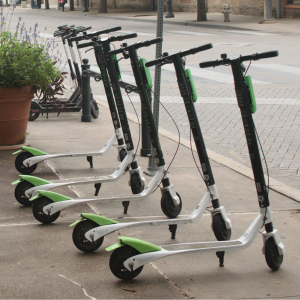Estimated reading time: 5 minutes
Doctors, Scientists, and Teachers aren’t the only ones hitting the books this year and gaining smarter insights towards how to best operate in these unpredictable times. We’ve all heard of smart futuristic cities, but now we’re onto the next slide with the “not-so-futuristic” era of smart buildings and what that means for citizens of the United States.  In the heat COVID-19’s worst blows, many have been forced to work from home, if they can, to eliminate person-to-person contact to help slow the spread of the virus. For those who don’t have that luxury, however, they’ve resorted to putting their health and safety on the line to continue effectively completing their jobs. Some actions are just unavoidable, like touching door handles, sitting in meeting rooms, and basic tasks like flipping on and off of light switches and toilet levers. Facial coverings, masks, gloves, and hand sanitizer containers are all the right tools to protect and disinfect in this instance, but wouldn’t it be easier if we didn’t have to lug these items around all the time, and could rely on the intelligence of the building instead?
In the heat COVID-19’s worst blows, many have been forced to work from home, if they can, to eliminate person-to-person contact to help slow the spread of the virus. For those who don’t have that luxury, however, they’ve resorted to putting their health and safety on the line to continue effectively completing their jobs. Some actions are just unavoidable, like touching door handles, sitting in meeting rooms, and basic tasks like flipping on and off of light switches and toilet levers. Facial coverings, masks, gloves, and hand sanitizer containers are all the right tools to protect and disinfect in this instance, but wouldn’t it be easier if we didn’t have to lug these items around all the time, and could rely on the intelligence of the building instead?
The Journey Back to Work
Smart buildings are known for using automated systems in order to grasp a sense of control over several functions like heating, ventilation, air conditioning, security, lighting, and many other environmental systems. These smart buildings will be made up of a complex network of sensors, switches, and microchips that will work to generate a constant flow, to feed into the larger model. Such infinitives have been introduced in greener and more sustainable working environments, but in the time of global pandemics and spreading germs, this lifeline can help sooner rather than later.
Similar to restaurants and grocery stores, sensors can be placed within smart workspaces to detect if employees are participating in the right social distancing guidelines. The more people that there are populating a specific area could increase the likely spread of germs and ultimately the virus, in these uncertain times. One can also install thermal imaging cameras in specific hallways and by entry points to scan and detect any 100.4 and up temperatures, alerting management and sending those employees to be tested and quarantine as needed. Developing a smart infrastructure for the lighting system, but also fire, security, and even desk orientation, should be enough to inspire employees to come back to work, knowing that we can work together to fight this infection, one shift at a time.
Outside of these buildings our several different metropolitan cities around the globe, and they too are thriving and surviving throughout this pandemic, but have been maturing for quite some time when it comes to ‘getting smart.’ Cities are “armoring up” with many new forms of micro-mobility, and thanks to COVID-19, that popularity is expanding.
Paving the Way for Future Applications
In many instances, Mobility-as-a-Service presents the introduction of “new” forms of transportation, such as bicycle sharing, car sharing and other innovative methods of demand-responsive transportation within the public transportation system. Ride Hailing and Ride Sourcing are also two other concepts that are widely popular in the United States at the current time, especially in cities where the licensing and owning of a vehicle isn’t as common as it might be in a more suburban and rural area.  The future of MaaS will require the transportation sector to undergo a huge transformation to society’s permission of technologies such as autonomous and electric vehicles, as additional modes of transportation for all usage points. Though they seem very ahead of the times, the technology features are all intact to get it working properly; it’s just up to the people and legislators to welcome it into cities and regions around us.
The future of MaaS will require the transportation sector to undergo a huge transformation to society’s permission of technologies such as autonomous and electric vehicles, as additional modes of transportation for all usage points. Though they seem very ahead of the times, the technology features are all intact to get it working properly; it’s just up to the people and legislators to welcome it into cities and regions around us.
What is an autonomous vehicle, you might ask? Autonomous Vehicles or AVs is essentially a self-driving car that has the potential to revolutionize the mobility and safety of the transportation sector. As the technology continues to develop, it’s up to state government officials to determine the legality and address factors that could impact the efficiency of these vehicles being on the road. Artificial Intelligence, Machine Learning, and other Deep Learning served the Automation industries in a huge way this year, and Tesla wasn’t the first one to innovate the Smart Car, self-driving concept. Tesla’s Autopilot feature was first introduced back in September of 2014, and many advances have been added since then to complete the invention for users.
From a ride-sharing perspective, it seems like everywhere you look ride-sharing innovators are popping up to offer you a ride to your location, especially in a time when basically nobody is out and about, because we are living through a pandemic. COVID-19 is actually boosting the need for less human contact,  and in the transportation sector, that can be implemented through more active options, such as bikes and scooters. Active transportation requires government officials to invest in safety-centric solutions to better allow for users to travel in an efficient way. Though these futuristic opportunities seem like a fix to it all, there are definitely some challenges put in place, for example, consider the more rural areas who don’t necessarily have access to smart parking lots and sustainable transportation options, whereas the more urban areas would because of their location and what’s placed around it.
and in the transportation sector, that can be implemented through more active options, such as bikes and scooters. Active transportation requires government officials to invest in safety-centric solutions to better allow for users to travel in an efficient way. Though these futuristic opportunities seem like a fix to it all, there are definitely some challenges put in place, for example, consider the more rural areas who don’t necessarily have access to smart parking lots and sustainable transportation options, whereas the more urban areas would because of their location and what’s placed around it.
There are many benefits to implementing intelligent mobility solutions, including a level of increased safety. Many road incidents that occur these days have to do with human error, whether the driver is distracted because of their mobile device, or isn’t familiar with their surroundings, the driver is typically always to blame in most urban driving experiences. Driverless cars and vehicles with semi-automatic features can help to increase roadway safety utilizing connected cars which own the ability provide advanced communication for commuters, with technological assistance, like blind-side detection sensors, back-up cameras, Bluetooth Cellular connections, and even GPS driving aid.
The demand for smart transportation has been steadily increasing as the months go on. Defining Mobility-as-a-Service in conjunction with Smart Transportation systems helps to provide access to autonomous opportunities for users so they may unlock a brand-new experience unlike any other. Many cities have been slow to build such smart-city/micro-mobility infrastructure throughout their geographic limits, but perhaps it’s a sign of the times that we can all regain a sense of normalcy again through various, comprehensive networks of connected vehicles, ride sharing platforms, and intelligent work spaces to navigate better and safer experiences for everyone.

